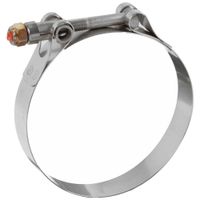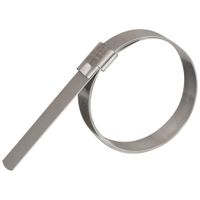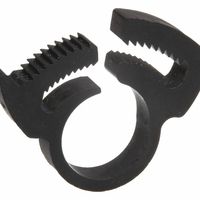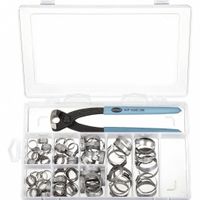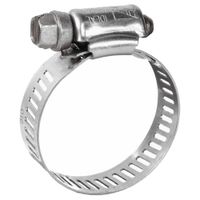Call +(254) 703 030 000 / 751 483 999 / 721 704 777
- Home
- Pipe Hose Tube Fittings
- Tube Hose Fitting Clamps
.....Read More
Frequently Asked Questions
What are the different types of tube and hose fitting clamps?
Tube and hose fitting clamps are essential components used to secure hoses and tubes in various applications. Here are the different types:
1. **Worm Gear Clamps**: These are adjustable clamps featuring a screw mechanism that tightens the band around the hose. They are commonly used in automotive and plumbing applications.
2. **Spring Clamps**: Made from a flexible metal, these clamps use the tension of the metal to hold hoses in place. They are often used in automotive cooling systems.
3. **Ear Clamps**: These clamps have a "ear" that is pinched to tighten the clamp. They provide a secure, tamper-proof seal and are used in pneumatic and hydraulic applications.
4. **T-Bolt Clamps**: Designed for high-pressure applications, these clamps use a bolt and nut to provide a strong, even clamping force. They are often used in heavy-duty applications like turbocharged engines.
5. **V-Band Clamps**: These clamps use a V-shaped band to secure flanged connections. They are commonly used in exhaust systems and turbocharger connections.
6. **Oetiker Clamps**: Similar to ear clamps, these are used for secure, permanent connections. They are often used in medical and beverage industries.
7. **Constant Tension Clamps**: These clamps maintain constant pressure on the hose, accommodating changes in temperature and pressure. They are used in automotive and industrial applications.
8. **Quick-Release Clamps**: Featuring a lever mechanism, these clamps allow for fast installation and removal. They are used in applications requiring frequent maintenance.
9. **Bolt Clamps**: These heavy-duty clamps use a bolt and nut to provide a strong clamping force, suitable for industrial and agricultural applications.
10. **Pincer Clamps**: Used for securing hoses in place with a pinching mechanism, often in low-pressure applications.
Each type of clamp is designed for specific applications, considering factors like pressure, temperature, and the environment in which they are used.
How do worm gear clamps work?
Worm gear clamps, also known as hose clamps, function by using a screw mechanism to tighten a metal band around a hose or tube, securing it to a fitting. The clamp consists of a band, typically made of stainless steel, with a series of slots cut into it. Attached to the band is a housing that contains a screw, also known as a worm drive.
When the screw is turned, it engages with the slots on the band. As the screw is tightened, it pulls the band through the housing, reducing the diameter of the loop formed by the band. This action increases the pressure exerted by the band on the hose, creating a secure seal between the hose and the fitting. The worm gear mechanism allows for precise control over the clamping force, ensuring a tight fit without damaging the hose.
The design of the worm gear clamp allows it to accommodate a range of hose diameters, making it versatile for various applications. It is commonly used in automotive, plumbing, and industrial settings to secure hoses carrying fluids or gases. The stainless steel construction provides resistance to corrosion and ensures durability, even in harsh environments.
Overall, the worm gear clamp is a simple yet effective device that relies on the mechanical advantage of the screw and the flexibility of the band to create a reliable seal.
What are the advantages of bolt-close clamps?
Bolt-close clamps offer several advantages:
1. **High Clamping Force**: They provide a strong and secure clamping force, ensuring that components are held tightly together. This is particularly beneficial in applications requiring high precision and stability.
2. **Durability**: Made from robust materials, bolt-close clamps are designed to withstand significant stress and wear, making them suitable for heavy-duty applications and long-term use.
3. **Versatility**: These clamps can be used in a wide range of applications, from industrial machinery to automotive and construction projects, due to their ability to accommodate various sizes and types of components.
4. **Adjustability**: Bolt-close clamps allow for easy adjustment of the clamping force by simply tightening or loosening the bolt, providing flexibility in different applications and ensuring optimal performance.
5. **Cost-Effectiveness**: They are generally more affordable compared to other clamping systems, offering a cost-effective solution without compromising on performance or reliability.
6. **Ease of Use**: The design of bolt-close clamps is straightforward, making them easy to install and operate, which reduces downtime and increases productivity.
7. **Safety**: By providing a secure hold, these clamps minimize the risk of components slipping or moving during operation, enhancing safety in the workplace.
8. **Minimal Maintenance**: With fewer moving parts, bolt-close clamps require less maintenance, reducing the time and cost associated with upkeep.
9. **Resistance to Environmental Factors**: Many bolt-close clamps are designed to resist corrosion, temperature fluctuations, and other environmental factors, ensuring reliable performance in various conditions.
10. **Customizability**: They can be customized to meet specific requirements, such as size, material, and clamping force, making them adaptable to specialized applications.
How are crimp-on ear clamps installed?
Crimp-on ear clamps are installed using the following steps:
1. **Select the Right Clamp**: Choose a clamp that matches the diameter of the hose or tubing you are securing. Ensure it is the correct size for a snug fit.
2. **Position the Clamp**: Slide the clamp over the hose or tubing before attaching it to the fitting or barb. Ensure the clamp is positioned near the end of the hose, covering the fitting's barb or ridge.
3. **Align the Clamp**: Make sure the clamp is evenly positioned around the hose. The clamp's ear should be accessible for crimping and not obstructed by any part of the fitting.
4. **Use the Right Tool**: Obtain a crimping tool or pincers specifically designed for ear clamps. These tools have jaws that fit over the clamp's ear to compress it properly.
5. **Crimp the Clamp**: Place the tool's jaws over the clamp's ear. Squeeze the tool handles firmly to compress the ear. This action tightens the clamp around the hose, ensuring a secure fit. Make sure the clamp is evenly crimped to avoid leaks.
6. **Inspect the Installation**: Check the clamp to ensure it is securely fastened and evenly crimped. The ear should be fully compressed, and the clamp should not be loose or able to rotate around the hose.
7. **Test the Connection**: After installation, test the hose connection for leaks by running fluid or air through the system. If leaks are detected, recheck the clamp's position and crimping.
8. **Final Adjustments**: If necessary, adjust the clamp or re-crimp to ensure a leak-free connection. Ensure the clamp does not damage the hose by over-crimping.
Following these steps ensures a secure and reliable connection using crimp-on ear clamps.
What applications are buckle-on clamps suitable for?
Buckle-on clamps are versatile fastening devices used in various applications across multiple industries due to their ease of installation and secure holding capabilities. They are particularly suitable for:
1. **Pipe and Hose Connections**: Buckle-on clamps are commonly used to secure hoses and pipes in plumbing, automotive, and industrial applications. They ensure a tight seal to prevent leaks and maintain pressure in fluid systems.
2. **Cable Management**: In electrical and telecommunications industries, buckle-on clamps help organize and secure cables, preventing tangling and reducing wear and tear. They are used in both temporary setups and permanent installations.
3. **Construction and Scaffolding**: These clamps are used to join scaffolding components, providing stability and safety. They are also employed in temporary structures and frameworks due to their quick assembly and disassembly features.
4. **HVAC Systems**: In heating, ventilation, and air conditioning systems, buckle-on clamps secure ductwork and components, ensuring efficient airflow and system integrity.
5. **Agricultural Equipment**: They are used in securing components of machinery and irrigation systems, providing reliable fastening in environments subject to vibration and movement.
6. **Marine Applications**: Due to their corrosion-resistant materials, buckle-on clamps are suitable for securing components on boats and ships, including railings, antennas, and other fixtures exposed to harsh marine conditions.
7. **Automotive Industry**: In vehicles, these clamps are used to secure fuel lines, air intake systems, and exhaust components, ensuring safety and performance.
8. **Manufacturing and Assembly**: In production lines, buckle-on clamps are used to hold parts in place during assembly, providing flexibility and efficiency in manufacturing processes.
9. **Event and Exhibition Setup**: They are ideal for assembling temporary structures like tents, stages, and displays, offering quick setup and takedown.
Overall, buckle-on clamps are favored for their adaptability, strength, and ease of use, making them indispensable in applications requiring reliable and efficient fastening solutions.
Can snap-on clamps be reused?
Snap-on clamps, often used in automotive, plumbing, and various industrial applications, are designed for quick and secure fastening. Whether they can be reused depends on several factors, including the type of clamp, material, and the specific application.
1. **Material and Design**: Snap-on clamps are typically made from materials like stainless steel, plastic, or other metals. Metal clamps, especially those made from stainless steel, are generally more durable and can often be reused if they have not been deformed or damaged during removal. Plastic clamps, on the other hand, may be more prone to wear and tear, making them less suitable for reuse.
2. **Condition After Use**: The condition of the clamp after its initial use is crucial. If the clamp maintains its original shape and integrity without any signs of stress, corrosion, or damage, it may be reused. However, if the clamp has been stretched, bent, or shows signs of fatigue, it should not be reused as it may not provide a secure fit.
3. **Application Requirements**: The decision to reuse a snap-on clamp also depends on the critical nature of the application. In high-stakes environments, such as automotive brake systems or critical plumbing connections, it is often recommended to use new clamps to ensure maximum reliability and safety.
4. **Manufacturer Guidelines**: Always refer to the manufacturer's guidelines regarding the reuse of snap-on clamps. Some manufacturers may specifically design clamps for single-use to ensure optimal performance and safety.
In summary, while some snap-on clamps can be reused, it is essential to assess their condition, the critical nature of the application, and adhere to manufacturer recommendations to ensure safety and functionality.
How do spring-tension clamps accommodate temperature changes?
Spring-tension clamps accommodate temperature changes through their inherent design and material properties. These clamps are typically made from materials with high elasticity and thermal expansion coefficients, such as stainless steel or certain alloys, which allow them to maintain consistent pressure over a range of temperatures.
The spring mechanism in these clamps is designed to exert a constant force, which compensates for the expansion and contraction of the materials they are holding. As temperatures rise, materials tend to expand, and as they fall, materials contract. The spring-tension clamp's elasticity allows it to adjust its grip automatically, maintaining the necessary tension without manual intervention.
Additionally, the design of the clamp often includes features like a helical or coil spring, which can expand and contract along with the temperature changes. This ensures that the clamp can adapt to the dimensional changes in the components it is securing, preventing loosening or over-tightening.
Moreover, the choice of materials for the clamp is crucial. Materials with low thermal conductivity and high resistance to thermal fatigue are preferred, as they can withstand repeated temperature cycles without losing their mechanical properties. This durability ensures that the clamp remains effective over time, even in environments with significant temperature fluctuations.
In summary, spring-tension clamps accommodate temperature changes through their elastic design, material selection, and the ability to maintain consistent pressure despite thermal expansion or contraction of the components they secure.
What is the installation process for heat-shrink clamps?
1. **Preparation**: Gather all necessary tools and materials, including the heat-shrink clamps, a heat gun or torch, and any additional components like wires or cables that need securing.
2. **Select the Right Size**: Choose a heat-shrink clamp that fits snugly over the components you intend to secure. The clamp should be slightly larger than the components before shrinking.
3. **Position the Clamp**: Slide the heat-shrink clamp over the components, ensuring it covers the area that needs securing. Make sure it is centered and aligned properly.
4. **Apply Heat**: Use a heat gun or torch to apply heat evenly around the clamp. Keep the heat source moving to avoid burning or damaging the clamp or components. The heat will cause the clamp to shrink and tightly secure the components.
5. **Monitor the Shrinking Process**: As the clamp shrinks, ensure it conforms tightly around the components. Adjust the heat application if necessary to achieve an even shrinkage.
6. **Cool Down**: Allow the clamp to cool down naturally. This will ensure it maintains its shape and grip on the components.
7. **Inspect the Installation**: Once cooled, inspect the clamp to ensure it is securely in place and there are no gaps or loose areas. The clamp should be tight and provide a secure hold on the components.
8. **Test the Connection**: If applicable, test the secured components to ensure they function correctly and the clamp does not interfere with their operation.
9. **Final Adjustments**: Make any necessary adjustments if the clamp is not holding securely or if there are any issues with the installation. Reapply heat if needed to achieve a better fit.
How do you choose the right clamp for a specific application?
To choose the right clamp for a specific application, consider the following factors:
1. **Type of Work**: Identify the task (e.g., woodworking, metalworking, welding) to determine the clamp type needed, such as C-clamps, bar clamps, pipe clamps, or spring clamps.
2. **Material**: Consider the material being clamped. Softer materials may require clamps with protective pads to prevent damage.
3. **Size and Reach**: Measure the size of the workpiece and the distance the clamp needs to span. Choose a clamp with an appropriate jaw opening and throat depth.
4. **Clamping Force**: Determine the amount of pressure required to hold the workpiece securely. Different clamps offer varying levels of force, so select one that provides sufficient pressure without damaging the material.
5. **Durability and Material**: Choose clamps made from durable materials like steel or cast iron for heavy-duty applications. For lighter tasks, aluminum or plastic clamps may suffice.
6. **Adjustability**: Consider clamps with adjustable features for versatility in different applications. Quick-release mechanisms can enhance efficiency.
7. **Environment**: If the application involves exposure to moisture or chemicals, select clamps with corrosion-resistant finishes or materials.
8. **Quantity**: Determine how many clamps are needed to distribute pressure evenly across the workpiece.
9. **Budget**: Balance quality and cost. Investing in high-quality clamps can be more economical in the long run due to their durability and performance.
10. **Brand and Reviews**: Consider reputable brands and read reviews to ensure reliability and customer satisfaction.
By evaluating these factors, you can select the most suitable clamp for your specific application, ensuring efficiency, safety, and quality in your work.
What are the common materials used for hose clamps?
Common materials used for hose clamps include:
1. **Stainless Steel**: Known for its corrosion resistance, strength, and durability, stainless steel is widely used in automotive, marine, and industrial applications. It can withstand harsh environments and is suitable for both indoor and outdoor use.
2. **Galvanized Steel**: This material is steel coated with a layer of zinc to prevent rusting. It is less expensive than stainless steel and offers moderate corrosion resistance, making it suitable for general-purpose applications.
3. **Brass**: Brass hose clamps are used in applications where conductivity and corrosion resistance are important, such as in plumbing and electrical systems. Brass is also resistant to tarnishing and is often used in decorative applications.
4. **Plastic/Nylon**: These materials are used for lightweight applications where metal clamps might be too heavy or conductive. Plastic and nylon clamps are resistant to corrosion and chemicals, making them suitable for use in environments where metal clamps might degrade.
5. **Aluminum**: Lightweight and resistant to corrosion, aluminum hose clamps are used in applications where weight is a concern, such as in aerospace and automotive industries. However, they are not as strong as steel clamps.
6. **Zinc-Plated Steel**: Similar to galvanized steel, zinc-plated steel offers a layer of zinc for corrosion resistance. It is used in less demanding applications where cost is a factor.
7. **Copper**: Used in specific applications where excellent thermal and electrical conductivity is required. Copper clamps are also resistant to corrosion and are often used in plumbing and electrical systems.
These materials are chosen based on factors such as the environment in which the clamp will be used, the type of hose being secured, and the specific requirements of the application.
